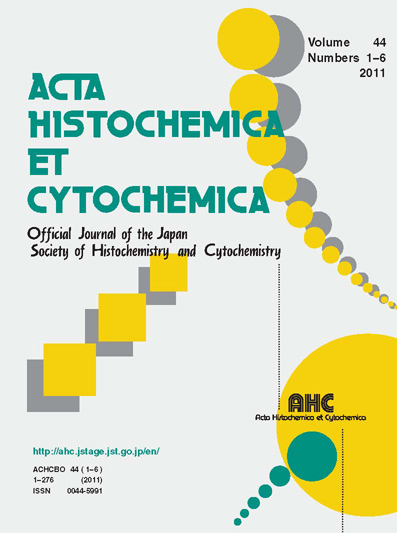
- 6 号 p. 149-
- 5 号 p. 135-
- 4 号 p. 119-
- 3 号 p. 105-
- 2 号 p. 57-
- 1 号 p. 1-
- |<
- <
- 1
- >
- >|
-
Yuki Shiroto, Shingo Terashima, Yoichiro Hosokawa, Kyoko Oka, Keitaro ...原稿種別: Regular Article
2017 年 50 巻 3 号 p. 105-109
発行日: 2017/06/26
公開日: 2017/06/27
[早期公開] 公開日: 2017/06/14ジャーナル フリー HTMLThe ciliary zonules link the lens to the ciliary body in the eye, controlling the thickness of the lens for focusing through their characteristic elasticity. The ciliary zonules are composed of oxytalan fibers. Physiological or pathological damage to the ciliary zonules, including exposure to ultraviolet (UV)-A and UV-B components, can lead to lens dislocation. However, no studies have shown whether UV affects the ciliary zonule. Here, we assessed the effects of UV light on human nonpigmented ciliary epithelial cells (HNPCECs). HNPCECs were cultured for 4 weeks, and expression of fibrillin-1 and fibrillin-2 was confirmed. In control cultures (0 mJ/cm2), some fibrillin-1-positive fibers were merged with fibrillin-2. After UV-A irradiation, the appearance of both fibrillin-1- and fibrillin-2-positive fibers was unchanged. However, after UV-B irradiation, fibrillin-1-positive fibers became thin at an irradiation level of 100 mJ/cm2, and the fiber structure became amorphous at 150 mJ/cm2. Fibrillin-2-positive fibers lost their continuity and disappeared after being exposed to 150 mJ/cm2 UV-B. UV-B irradiation did not affect cell viability, possibly because of the sensitivity of fibrillin-1 and fibrillin-2 to UV-B. Thus, dislocation of the lens with age may be attributable to cumulative exposure to UV-B.
抄録全体を表示PDF形式でダウンロード (977K) HTML形式で全画面表示 -
Hiroshi Watanabe, Haruka Takahashi, Miyuki Hata-Kawakami, Akira Tanaka原稿種別: Regular Article
2017 年 50 巻 3 号 p. 111-118
発行日: 2017/06/26
公開日: 2017/06/27
[早期公開] 公開日: 2017/06/22ジャーナル フリー HTMLLong-term submandibular duct obstruction is thought to cause irreversible atrophy and dysfunction of the submandibular gland. As an atrophic gland may be induced clinically by chronic or recurrent infection, it is generally removed surgically. However, the regenerative capacity of atrophic submandibular glands after long-term obstruction is not completely understood. We studied the regenerative capacity of the mouse submandibular duct using an aneurysm clip ligation model. We documented changes in the size, histologic structure and gene expression of the submandibular gland after 2 months of ligation, and 1 week, 1 month and 2 months after clip removal. Two months of ligation caused atrophy, particularly in the acinar portion. In the 2 months after clip removal, we observed a steady and significant increase in the expression of the acinar cell precursor gene cytokeratin 5 (CK5), and a significant decrease in the expression of the stem cell marker c-kit. These findings suggest that the submandibular gland retains some capacity for regeneration even after long-term obstruction, and that CK5 could serve as a marker of this regenerative process.
抄録全体を表示PDF形式でダウンロード (2228K) HTML形式で全画面表示
- |<
- <
- 1
- >
- >|